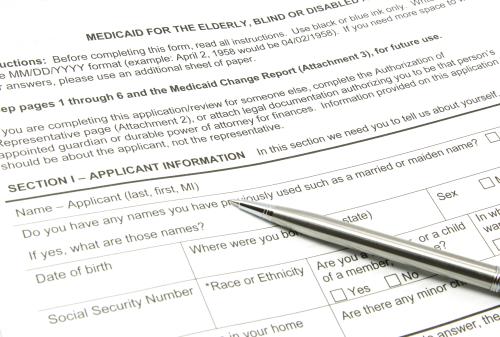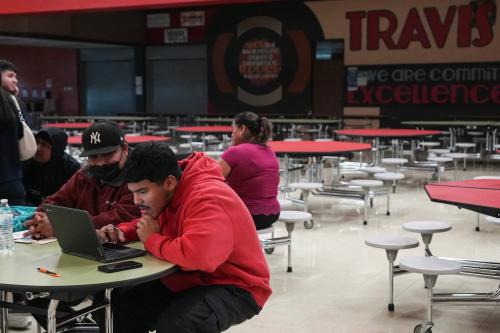If you want more content like this, subscribe to our newsletter.
This week in Class Notes:
- Mortality is increasing among less educated Americans.
- Taking away Supplemental Security Income increases the likelihood of crime.
- Administrative burdens negatively impact participation in programs.
- This week’s top chart shows that mothers spend more time on secondary child care than fathers.
- Policy itself notwithstanding, the delivery of the student loan forgiveness program is worth celebrating, argue Pamela Heard and Donald P. Moynihan in this month’s choice op-ed.
- Check out our new piece on education gender gaps in the United States.
- For your calendar: events on monopsonies and wages, worker cooperatives and improving housing services for people with disabilities.
Mortality is increasing among less-educated Americans
Growing gaps in mortality rates, including from so-called “deaths of despair” have received a great deal of attention in recent years from researchers, policymakers and the media. The higher death rates of working class Americans, especially whites, has sparked particular worry. But a key concern with the recent literature on education levels and mortality rates is the likelihood of selection bias. The share of the population with low levels of education is declining over time, and it may be that there is increasing negative selection into this shrinking group. In a new paper, Paul Novosad and co-authors use the Current Population Survey and the U.S. National Vital Statistics System to get death rate data by race, gender and education. They find that among both white men and women, increases in mortality rates are being driven by the bottom 10% of their gender’s education distribution. The paper underscores the shifting heterogeneity in mortality rates across age, race, place and class.
Taking away Supplemental Security Income increases the likelihood of crime
Can more money mean less crime? Menashi Deshpande and Michael Mueller-Smith find that removing Supplemental Security Income (SSI) increases the likelihood of criminal activity and incarceration. Using a regression discontinuity design based on the 1996 policy of mandatory SSI review for eligibility at age 18, they link Social Security Administration data to the Criminal Justice Administrative records. Almost all children with an 18th birthday before the enactment of the reform on August 22, 1996 continued receiving SSI payments, while about 40% of children born after the date lost out on SSI after their review at age 18. The loss of SSI payments increased the number of criminal charges by about 20%, with most of the activity happening in income-generating activities such as robbery and theft. The authors credit the rise in criminal activity to both a lack of formal employment following the Great Recession and a development in “criminal capital.” The authors estimate that crime and incarceration is more costly to the taxpayer than the savings from removing SSI.
Administrative burdens negatively impact participation in programs
What impact do administrative burdens have on program participation? Iris Arbogast and co-authors evaluate how audits and enhanced data requirements impact participation in public health insurance under CHIP and Medicaid. Using state-level data on enrollment from 2014-2020 and a broad range of sources on policy changes—including news articles, legislation, documents and lawsuits—they find that greater burdens caused a decline in initial enrollment of 1.8 percentage points that grew to a peak decline of 2.3 percentage points six months after the policy change. They also find that higher burdens had a much bigger impact on certain groups, being three times larger for Hispanic families and four times greater for children with non-citizen parents. This suggests that increased administrative hurdles may have caused some anxiety with regard to public benefits and immigration status.
Top chart: Mothers spend more hours per day on secondary child care than fathers
COVID-19 presented child care challenges for parents across the United States. Among those with young children, full-time working mothers spent an extra 2.1 hours a day on secondary child care responsibilities in 2020 compared to 2019. Among fathers the increase was 0.8 more hours.

Choice opinion: Turns out sometimes the government can get things right
“Setting aside the conflict over policy, the streamlined [student loan forgiveness] application shows what is possible when government prioritizes the public in the delivery of public services. The form can be completed in just a couple of minutes. It works on both a computer and a smartphone, and it is available in Spanish and English. It’s three simple pages: a welcome page, a form and a confirmation page on which applicants attest that they are eligible. Beneficiaries do not have to create an account with a password, a seemingly small step that can actually discourage people from starting. Applicants need five pieces of information: name, Social Security number, date of birth, phone number and email address. That’s it,” write Pamela Heard and Donald P. Moynihan in the New York Times.
Self-promotion: Across subjects and education levels, girls are outpacing boys
In every U.S. state, girls are more likely to complete high school and obtain a college degree than boys. Building off the work in “Of Boys and Men,” Ember Smith and Richard Reeves look at state level variation in the gender gaps in test scores and educational attainment. Not only are boys falling behind in high school and college completion, but they are beginning to fall behind in standardized tests too.
For your calendar: events on monopsonies and wages, worker cooperatives, and improving housing services for people with disabilities
Power and dignity in the low-wage labor market: Theory and evidence from Wal-Mart workers
Federal Reserve Bank of Boston
Monday, December 19, 2022 1:45 PM – 3:00 PM EST
Democratizing work: The role, opportunities, and challenges of worker cooperatives in the US
Aspen Institute
Thursday, November 17, 2022 2:00 PM – 3:15 PM EST
Improving experiences for residents with disabilities in federally assisted family housing
The Urban Institute
Wednesday, November 16, 2022 12:15 PM – 1:30 PM EST








Commentary
Class Notes: Mortality rates, parents’ spending on child care, and more
November 9, 2022